With chewy rice noodles coated in a sweet and sour sauce and topped with plenty of peanuts, it's no wonder that Thai Stir Fried Noodles known as Pad Thai is one of the most loved Thai dishes in the world.

Pad Thai is a popular street food in Thailand, and is the signature dish of many western Thai restaurants. It is one of the few dishes that everyone associates with Thai food, and is loved not just in Thailand, but all around the world.
For being so popular, pad Thai is not super straightforward to make. It requires proper hydration of dry rice noodles, a trained palate to balance the flavors of the sauce, and the use of numerous hard-to-find ingredients. I don't say this to scare you off from making it, but to demonstrate the many ways in which this delicious noodle dish can go wrong.
Fortunately, over many years of trying to perfect my pad Thai, I have worked through each of these possible obstacles. And now I am happy to share all of my best tips with you. Here is my guide for making an absolutely delicious pad Thai! Ready? Let's go!
Jump to:
What is Pad Thai?
Pad Thai is a stir fried noodle dish that originated in Thailand in the 1930s or 40s. It is said to have been the winning recipe of a nationwide competition to create a new noodle dish, which was held as a means to increase noodle consumption in the country. To distinguish this winning dish from Chinese noodle dishes, it was named pad Thai. Pad means "to stir fry", and the dish is often translated as Thai stir fried noodles (see How to Interpret a Thai Menu).
Like other noodle dishes in Thailand, Pad Thai is commonly eaten for a quick lunch or a late night snack. You can find street vendors selling it all over Thailand, with slightly different variations in different regions of the country. It is now famous throughout the world, and has become a symbol of Thai food wherever you go.
Ingredients
Pad Thai is made with an impressive list of ingredients, some of which can be hard to find, depending on where you live. At its most basic, this Thai Stir Fried Noodles dish requires rice noodles, eggs, shrimp, garlic chives, bean sprouts, peanuts, and a sauce made from tamarind and palm sugar. A more complete pad Thai will include all of the ingredients shown in the picture above:
- Garlic and shallots: These aromatics should be chopped finely.
- Salted radish: This ingredient is daikon radish that has been pickled then dehydrated. It is also known as preserved or pickled radish/turnip and you can find it at Asian grocery stores or online. It may be whole, in strips, or already chopped; any of these works as you will be chopping them finely for pad Thai.
- Fried tofu: Fried tofu can be bought pre-made at Asian grocery stores, or made at home by pan frying a block of firm tofu until its outside is golden brown.
- Shrimp: In Thailand, tiny dried shrimp are commonly used, but you'll find fresh shrimp in its place in western Thai restaurants. You can also substitute chicken, pork, beef, crab, or lobster, or just omit this protein, if you prefer.
- Shrimp paste in oil: Made to mimic the natural fatty substance found in shrimp heads, this oily paste lends a shrimp-y flavor and characteristic reddish color to pad Thai.
- Rice Noodles: Pad Thai can be made with fresh or dried rice noodles. Dried rice noodles are more readily available outside of Thailand, and require rehydrating prior to use. See below section on noodle rehydration for more details.
- Egg: The egg can be added whole and scrambled in the pan, or beaten before adding to the pan. The most important part of adding it is to move the noodles away first, so that the egg doesn't coat the noodles before being cooked.
- Bean Sprouts: Fresh bean sprouts are added to pad Thai right before you take it off the burner so that they stay fresh and crunchy.
- Garlic Chives: Garlic chives, also known as Chinese chives, provide an essential aroma and taste to pad Thai. They are also added right before taking off the burner, as well as on the side as an accompaniment. They taste different than green onions, so it's best not to substitute them.
- Roasted Peanuts: Dry roasting peanuts at home is the best way to go. Follow this tutorial to make perfect roasted peanuts to use in Thai cooking.
- Tamarind paste, fish sauce, palm sugar, white sugar: These ingredients are used to make the pad Thai sauce. See section below for more details.
- Lime wedges, roasted chili flakes, and white sugar: These are essential accompaniments to serve with pad Thai so that individual diners can adjust the flavor to their personal preferences. An assortment of raw vegetables such as banana blossom or pennywort are also often served with pad Thai in Thailand.
It's important to prep and assemble all of the ingredients before you start making pad Thai. Once you've turned the heat on, you won't have time to chop the garlic, slice the tofu, or roast the peanuts.

Making the pad Thai sauce
The sauce used to coat the rice noodles is the single most important ingredient in pad Thai. It's what gives this noodle dish its characteristic flavor: sour from tamarind paste, sweet from palm and white sugars, and salty from fish sauce. The balance of these disparate flavors is key. If the sauce is too sour, your pad Thai will likewise be too sour. If it is too sweet, your pad Thai will also be too sweet.
You can make your own tamarind paste by squeezing a block of wet tamarind with warm water, then straining it to get the seeds and veins out. Tamarind paste is available as a ready-made concentrate at many Asian stores, although the sourness of this paste may be different than homemade tamarind paste.
Once your tamarind paste is ready, the sauce is quite simple to make. Mix all ingredients over medium heat until the sugars are dissolved. Then, do a taste test. The sauce should have a good balance of sour, sweet, and salty. If any one flavor is too pronounced, add more of the other ingredients to balance it out.
Rehydrating the rice noodles
Outside of Thailand, it is easier to find dried rice noodles than fresh rice noodles. You can rehydrate them either by soaking in warm water or by parboiling in a pot of hot water.
In all of my attempts at pad Thai, when I take the "soak in warm water" route, the noodles are still quite tough and require stir frying for very long time in order to be edible. Therefore, I prefer the pre-cooking method. After experimenting with a kitchen timer, I found that parboiling the noodles for 6 minutes produced the perfect noodle consistency for me. They are soft and chewy, but not so soft that they stick together after stir frying. I'd encourage you to do the same experiment in your own kitchen to find what method works best for you.
Cooking pad Thai
Once your ingredients are prepped, sauce is made, and noodles are rehydrated, it's time to start cooking!
- Add a mild flavored oil to a wok and heat over medium high heat. Add the garlic, shallots, and salted radish and cook until the garlic is golden brown.
- Add the fried tofu and shrimp and cook for a minute or two until cooked through.
- Add the rehydrated rice noodles, pad Thai sauce, and shrimp paste in oil. Stir until the noodles have absorbed all of the sauce.
- Move the noodles to the side of the wok and scramble an egg on the other side. Once it's done, incorporate it with the noodles.
- Add the bean sprouts, garlic chives, and peanuts. Stir fry for a few more seconds until the chives are just wilted.
- Take off the heat and serve with lime wedges, chili powder, and white sugar.
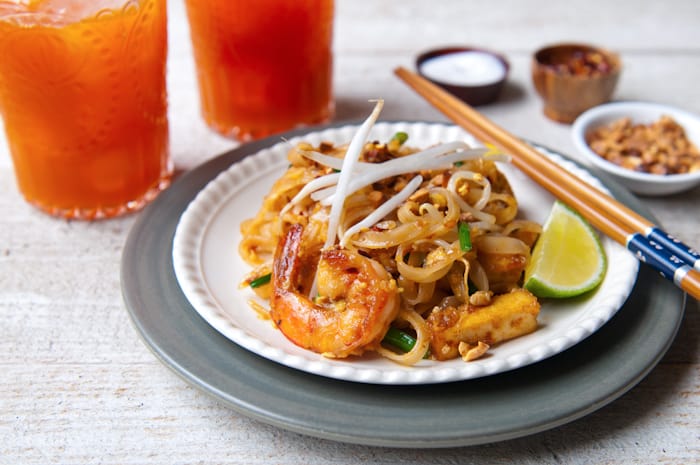
Tips for making the best pad Thai
- Start with the right ingredients: The list of ingredients for pad Thai is long, I know. However, they all play a role in making a great pad Thai. If you are not able to find all of the ingredients, the most important ones are rice noodles, pad Thai sauce, tofu, egg, bean sprouts, garlic chives, and peanuts. Don't skip out on any of those!
- Taste test the sauce: As I mentioned above, the sauce is the single most important ingredient in making a great pad Thai. Since your tamarind paste will vary in sourness, it's important to taste test it to ensure that the balance of flavors is correct.
- Experiment with the noodle rehydration in your own kitchen: In my hands and my kitchen, pre-cooking the rice noodles works best. Indeed, many chefs in Thailand pre-cook their noodles in this way. There are also many Thai chefs who insist that pre-cooking will lead to clumpy noodles and highly discourage it. I'd encourage you to experiment and see what works best for you, in your kitchen.
- Add enough sauce: In addition to having a great pad Thai sauce, it's important to get the sauce to noodle ratio just right. Because no matter how good your sauce is, if you don't add enough of it, you're going to end up with bland noodles. And there's nothing worse than a bland pad Thai.
- Make a single serving at a time: Pad Thai is best when it's eaten immediately after it's been made. The longer it sits on the table, the more opportunity the noodles have to clump together. Therefore, I wouldn't recommend serving this to a large dinner party. It is best made as a single serving dish.
Variations
Variations of pad Thai abound. Although using dried shrimp in this noodle dish is most common in Thailand, using fresh shrimp is more common in the West. If you prefer, you can substitute the shrimp for chicken, pork, beef, crab, lobster, or any other protein you prefer, or omit it altogether.
Pad Thai can also be made with woonsen noodles instead of rice noodles. They are easier to work with, and absorb the delicious flavors of the sauce just as well as rice noodles do.
Another fun variation on pad Thai is to serve it wrapped in a thin omelet. This is known as pad Thai hor kai.

The recipe and video below incorporate everything I've learned about making pad Thai over the years. I hope this guide helps in making your next pad Thai the best you've ever eaten!
Recipe

Thai Stirfried Noodles | Pad Thai | ผัดไทย
Ingredients
Pad Thai Sauce
- 1 Tablespoon tamarind paste see instructions below
- 1 Tablespoon fish sauce
- 1 Tablespoon palm sugar
- 1 Tablespoon white sugar
Pad Thai Noodles
- 1 teaspoon garlic chopped
- 1 teaspoon shallots chopped
- 1 teaspoon salted radish chopped
- ¼ cup fried tofu sliced into small rectangular pieces
- 3-4 medium sized shrimp peeled and deveined
- 4 Tablespoons pad Thai sauce
- 1 Tablespoon shrimp paste in soya bean oil
- 1 egg
- 2 ounces dry medium size rice noodles
- ¼ cup bean sprouts
- ¼ cup garlic chives cut into 1" pieces
- 2 teaspoons roasted peanuts chopped
- lime slices roasted chili flakes, white sugar as accompaniments
Instructions
To Make Pad Thai Sauce:
- Make tamarind paste by mixing ¼ cup of wet tamarind with ½ cup of hot water. Mash between your fingers until the tamarind forms a paste and then strain to get all seeds and veins out.
- Mix the tamarind paste with the other sauce ingredients and heat over medium heat until everything is dissolved.
To Make Pad Thai Noodles:
- Prepare your pad Thai sauce and all other ingredients. Once you start cooking, you won't have time to wash, chop, or mix anything.
- Heat a pot of water on medium heat until small bubbles appear on the bottom. Blanch the rice noodles in this water for 6 minutes.
- Meanwhile, heat a wok to medium-high heat. Add a bit of oil and wait until it's hot. Then add the garlic, shallots, and salted radish and saute until garlic is golden brown.
- Add the fried tofu and shrimp and saute until they are cooked through. By the time they're done, your rice noodles should also be done.
- Drain the rice noodles and immediately put into the wok. Add the pad Thai sauce and shrimp paste in soya bean oil and stir to incorporate.
- Move everything to the side of the wok and scramble an egg on the other side. Once it's done, incorporate it with the noodles.
- Add the bean sprouts, garlic chives, and peanuts. Stir fry for just a few seconds more until the chives are barely wilted. Take off the heat immediately.
- Serve with lime slices, roasted chili flakes, and white sugar on the side. Enjoy!


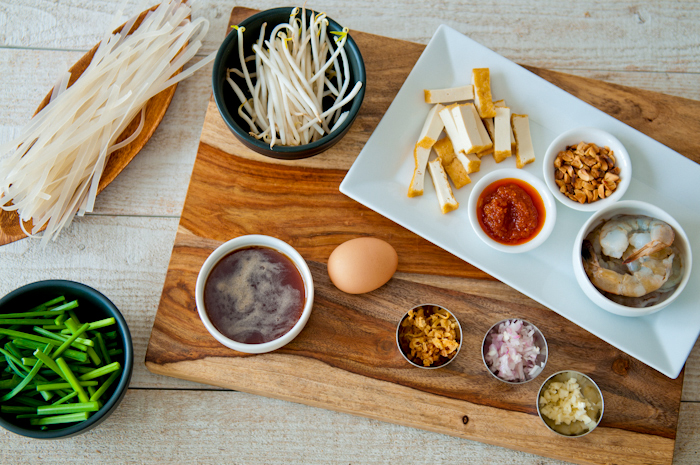
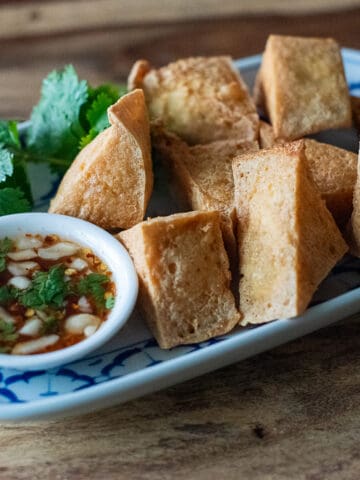
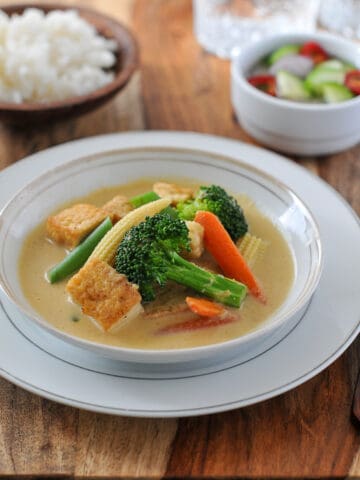
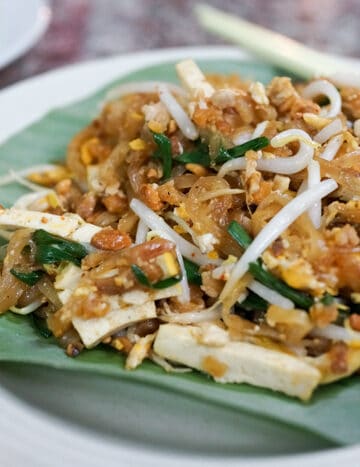
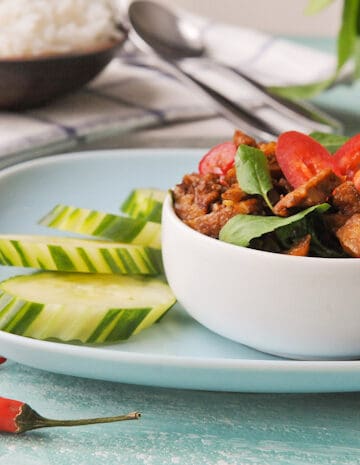
KAREN LUCAS
I love Pad Thai but have never made it. Question; what is "salted radish"?
admin
Hi Karen! Salted radish is sliced radish that's been preserved in salt. You can find it here: https://amzn.to/3IKfzFs
Anne N
I am just stunned at how beautiful and delicious these recipes look! Your instructional video makes it easy to follow. I can’t wait to try some of these out! Thanks for sharing!
Kiki
I grew up in Seattle with tons of delicious Asian food within 5 minutes of my house. I now find myself in city/state with nearly NO good Asian food, so I was delighted to find your blog! For me, this recipe is superb! Exactly like a lot of the Pad Thai I grew up eating in Seattle. My favorite is chicken Pad Thai, so I swapped the shrimp for chicken. I'm not sure if the switching made the difference, but the shrimp paste was a little heavy for my taste when doing it with chicken, so I reduced the shrimp paste by nearly half and it turned out perfect. THANK YOU!!! I've been dying for some good Thai, and am so excited that I can now eat delicious Thai I make at home! THANK YOU!!!! Trying out the Yellow Curry next per my hubby's request. Can't wait to try it!
Rachel
Hi Kiki, thanks for the report back! I'm so glad that you gave it a try and enjoyed it 🙂